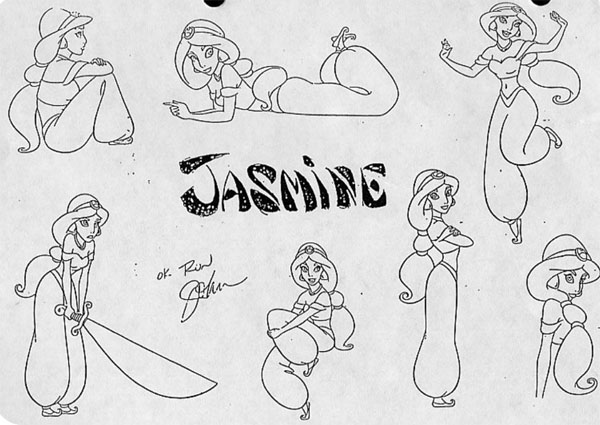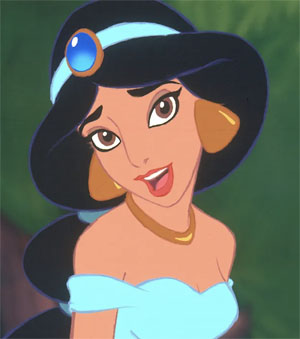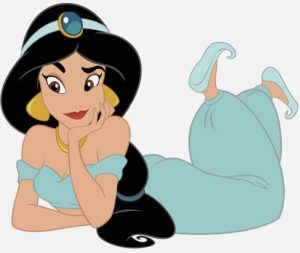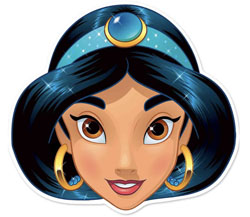 Suspended Animation #413
Suspended Animation #413
Princess Jasmine from the Disney animated feature Aladdin (1992) perhaps does not get enough recognition for some significant milestones.
She was the first non-Northern European Disney princess so most Americans consider her the first ethnic princess because of the color of her skin. She was the first Disney princess where one performer did the speaking lines and another performer provided the singing voice.
Writer Howard Ashman who started work on the project while finishing The Little Mermaid (1989) proposed two potential love interests for Aladdin: Jasmine and a tomboyish character reminiscent of a young Judy Garland whose affections are not reciprocated by Aladdin.
Naturally, Disney changed the name of the princess from the original The Arabian Nights and decided on “Jasmine” because of the popularity of the actress Jasmine Guy at the time on the television show A Different World. In fact, Disney artists even did some preliminary sketches of the character based on the facial features of the actress but felt the look was too severe.
Obviously the facial expressions and movement of blonde-haired, twenty-one year old American actress Linda Larkin who voiced the character of Jasmine provided some of the inspiration for the final design. Animator Mark Henn looked at a number of different exotic models.

The speaking voice of Jasmine, Linda Larkin
Henn also was inspired by the appearance of actress Jennifer Connelly, specifically her eyebrows. Model Robina Ritchie did some live action reference modeling for the character performing to Larkin’s pre-recorded lines.
As Larkin remembered, “Mark and I went out to dinner on the Disney MGM lot and he told me, ‘Jasmine will be a little bit of you, a little bit of me and a little bit of Robina Ritchie’. And the final version was also a little bit of singer Lea Salonga who was brought in to do the singing voice for the character. Jasmine was a combination of all of us.”
As Henn recalled, “It was a little challenging at that point because I had done several Disney princesses in a row, so I really wanted to try to do something different. But I needed something fresh to help with the physical look of her. That’s where my sister’s photograph became invaluable. But I had also Linda Larkin who was the voice of Jasmine to get my inspiration.”

Art director Bill Perkins based Jasmine’s design on the famous Taj Mahal particularly the curves demonstrated in the character’s hair, clothes and jewelry.
Animator Andreas Deja who supervised the character of Jafar told the Los Angeles Times, “We thought of each character in terms of two-dimensional shapes. Aladdin is composed of two inter-locking triangles formed by his chest and his pants. Jasmine is sort of pear shaped. Jafar is basically a ‘T’ – a very skinny body with these broad shoulders.”
 Henn said, “Everything gets run past Jeffrey (Katzenberg) for approvals and he’s a real strong romantic. He likes his leading ladies to be very attractive. I wanted to make her a real babe.
Henn said, “Everything gets run past Jeffrey (Katzenberg) for approvals and he’s a real strong romantic. He likes his leading ladies to be very attractive. I wanted to make her a real babe.
“I was nervous when I first unveiled Jasmine but he said, ‘Home run’. Then he looked at me and asked, ‘What is it with you and these women (Ariel, Belle)?’ Jasmine turns on this playful, false come-on to Jafar that was something we’ve never shown before.”
Jasmine’s light blue dress was meant to represent water, the most precious substance in the desert. In fact, her first scene was next to a fountain to emphasize that connection. That pool was inspired by a photograph taken by Layout head Rasoul Azadani in front of a mosque in his home town of Ispahan, Iran.
The movie is vague about the specific time period but Jasmine is certainly dressed in a manner not consistent with most Middle Eastern cultures including not only showing in public her feminine shape but her bare midriff and navel.
Her attire is more reminiscent of the stereotypical “harem girls” that appeared in Hollywood movies and is perhaps more inspired by Indian culture. Over the years, the Walt Disney Company has gradually made her clothing more and more modest, especially for the costumed character in its theme parks, so that it covers more skin.
Jasmine is fifteen years old but on the verge of her sixteenth birthday when by the law of Agrabah she must be married to a prince which is why the Sultan has filled the palace with suitors for her hand in marriage.
 As Henn remembered, “Our original plot line for Aladdin had the Sultan saying, ‘Jasmine, the law says you must be married by your sixteenth birthday’. That was the original story concept and it stayed for quite a while. Then Jeffrey (Katzenberg) started to worry about what kind of a message we would be sending all the fifteen year olds in the world – that it’s okay to get married before your sixteenth birthday?
As Henn remembered, “Our original plot line for Aladdin had the Sultan saying, ‘Jasmine, the law says you must be married by your sixteenth birthday’. That was the original story concept and it stayed for quite a while. Then Jeffrey (Katzenberg) started to worry about what kind of a message we would be sending all the fifteen year olds in the world – that it’s okay to get married before your sixteenth birthday?
“Of course, Aladdin is a fairy tale and presumably happened a long time ago but he thought it would be better to change the line to ‘married to a prince by your next birthday’. Jeffrey added ‘prince’ to make it more clear.”
In the first scene, Jasmine releases birds from their aviary cages to suggest a metaphor to her situation where she is forbidden to go beyond the palace walls and is taken care of and provided for but feels trapped.
That is one of the reasons that she relates to Aladdin who also feels trapped by his poverty and the perception he is just a street rat.
 This theme is emphasized by the appearance of Jasmine’s boudoir which very much resembles a covered birdcage. This feeling of not being in control of her own destiny is one of the underlying reasons for her rebellious nature against what she feels are unjust laws.
This theme is emphasized by the appearance of Jasmine’s boudoir which very much resembles a covered birdcage. This feeling of not being in control of her own destiny is one of the underlying reasons for her rebellious nature against what she feels are unjust laws.
The scene of Jasmine disguising herself and escaping the palace to experience the real world was inspired by the Audrey Hepburn 1953 movie Roman Holiday. Hepburn plays Princess Ann who is visiting Rome but struggles against her security that keeps her sheltered so sneaks out of the royal embassy to enjoy being a “regular person” for one day and meets a man and they fall in love. Her bodyguards come after her.
Co-director Ron Clements said, “In Howard Ashman’s original version of the story, Princess Jasmine was not a really sympathetic character. She was kind of spoiled and Aladdin didn’t end up with her. She actually had a small role.
“It was more of a buddy story that was very old Hollywood, an exotic romp in the Arab world. In fact, Mark Henn was assigned to animate Aladdin’s mother who had a bigger role than Jasmine. When that character was cut by Katzenberg, Mark moved over to Jasmine and her role was expanded.”


 Jim Korkis is an internationally respected animation historian who in recent years has devoted his attention to the many worlds of Disney. He was a columnist for a variety of animation magazines. With his former writing partner, John Cawley, he authored several animation related books including The Encyclopedia of Cartoon Superstars, How to Create Animation, Cartoon Confidential and Get Animated’s Animation Art Buyer’s Guide. He taught animation classes at the Disney Institute in Florida as well as instructing classes on acting and animation history for Disney Feature Animation: Florida.
Jim Korkis is an internationally respected animation historian who in recent years has devoted his attention to the many worlds of Disney. He was a columnist for a variety of animation magazines. With his former writing partner, John Cawley, he authored several animation related books including The Encyclopedia of Cartoon Superstars, How to Create Animation, Cartoon Confidential and Get Animated’s Animation Art Buyer’s Guide. He taught animation classes at the Disney Institute in Florida as well as instructing classes on acting and animation history for Disney Feature Animation: Florida.




















































After Robin Williams died, my wife and I watched “Aladdin” together and got into a big argument about Princess Jasmine afterwards. She felt that nothing really changed for Jasmine, as the law forcing her to marry a prince was repealed by the Sultan’s fiat and therefore could conceivably be overturned by him or his male successors at any time on a whim. Jasmine still has no say in matters that concern her and remains at the mercy of a patriarchal power structure. I argued that the film pointedly distinguishes between power and freedom: the Genie possesses great power but no freedom; the princess and the street rat both feel similarly “trapped” in their roles; Jafar craves power but has no understanding of freedom, which turns out to be his undoing. Oh well, both Aladdin and I know it’s a losing battle when you’re up against these headstrong brunettes.
Since the princess in the original Aladdin story was named “Badroulbadour”, I think “Jasmine” was a definite improvement.
Glad to have you back in the saddle again, Jim. These articles about the Disney Princesses are great! Any chance of a book on the subject?
I guess your wife was a woman slightly ahead of her time, as Disney’s 2019 live action(ish) remake changes it so Jasmine changes the law herself. IMO it takes away a nice character moment for the Sultan. I guess I just took it on faith that no one would consider changing the law back.
In the original Arabian Nights tale, the name of the Princess is Badr al-Budur. But the Jasmine name has a precedent in the earlier animated take on the Aladdin story produced by UPA and featuring the character of Mr. Magoo, “1001 Arabian Nights” in which her name is Yasminda. There seems to be some evidence that the Disney film was strongly inspired by the UPA film, including a blue design for the Genie as well as the naming of the Princess. (Although the Genie was also blue in the Popeye version from the Fleischer studio.) And also UPA’s version of the Wicked Wazir bears more than a passing resemblance to Jafar, while the Sultans in both versions seem to have a sort of family resemblance.
The 1992 feature and its movie and TV spinoffs do not represent the only time that Disney adapted the tale of Aladdin. As Greg Ehrbar has documented in Animation Spin, there was a Disneyland Records album that presented a more traditional version of the story. Though the story on the record is not presented with as much drama or suspense as the later Disney treatment, the album has a strong voice cast and is supported by the music of Rimsky-Korsakov.
Great article, which explains why Jasmine is my favorite Disney heroine. They really did the movie a huge favor by dropping the mother character entirely and focusing on the parallels between Aladdin and Jasmine instead.
Regarding Jasmine, I believe it was Pepe Le Pew who said it best:
“Rowrrrrrr!”
Agreed!
She is based on Princess Yum-Yum from Richard Williams’ The Thief and the Cobbler, who is implied to be Indian on her mother’s side, and Persian on her father’s.
If Andreas Deja should happen to read these lines, remember that wire sculpture of a deer you made years ago? It’s hanging in our family room (at Christmas time I put a red ball nose on him and he becomes Rudolph) and probably out of shape because it’s been moved so often in the last 25 years. So if you get a chance…
Lea Salonga provided the singing voice of Jasmine in the original film, and the sequels had the singing by Liz Callaway.